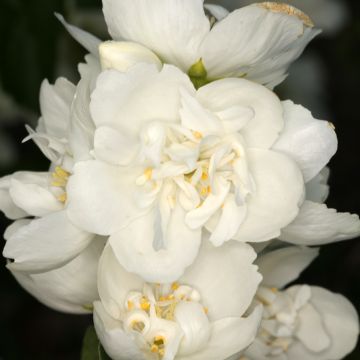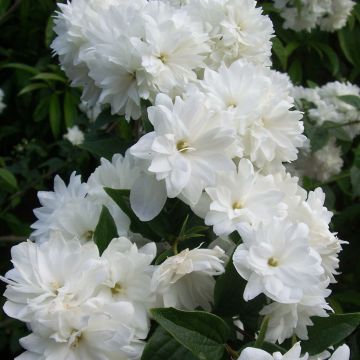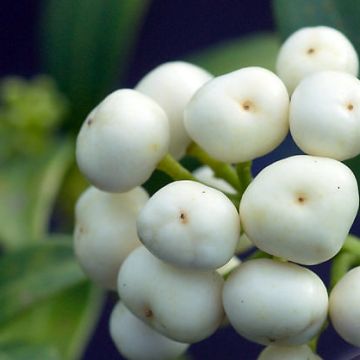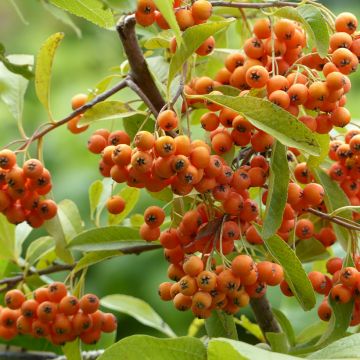

Philadelphus coronarius - Mock Orange


Philadelphus coronarius - Mock Orange


Philadelphus coronarius - Mock Orange


Philadelphus coronarius - Mock Orange
Philadelphus coronarius - Mock Orange
Philadelphus coronarius
Mock Orange
This item cannot be shipped to the selected country
Delivery charge from €5.90
Delivery charge from €5.90
Delivery charge from €5.90
Delivery charge from €5.90
Delivery to Corse prohibited
More information
Schedule delivery date,
and select date in basket
This plant carries a 24 months recovery warranty
More information
We guarantee the quality of our plants for a full growing cycle, and will replace at our expense any plant that fails to recover under normal climatic and planting conditions.
From €5.90 for pickup delivery and €6.90 for home delivery
Express home delivery from €8.90.
From €5.90 for pickup delivery and €6.90 for home delivery
Express home delivery from €8.90.
From €5.90 for pickup delivery and €6.90 for home delivery
Express home delivery from €8.90.
From €5.90 for pickup delivery and €6.90 for home delivery
Express home delivery from €8.90.
Delivery to Corse prohibited: UE law prohibits the import of this plant from mainland France to Corse as part of the fight against Xylella fastidiosa. Please accept our sincere apologies.
More information

Does this plant fit my garden?
Set up your Plantfit profile →
Description
The Philadelphus coronarius is also known as Mock Orange. It must be acknowledged that this remarkably resistant bush is one of the contenders, if not the winner in the fragrance race. Once neglected in favour of double-flowering hybrids, which are more spectacular, this slightly untidy botanical species with simple white flowers, reminds us a little of what happened with roses as their appearance has supplanted their powerful scent.
The Philadelphus coronarius, cultivated for a very long time, is native to Asia Minor and the southern half of Europe. It is now naturalized in many temperate regions, including France. It belongs to the Hydrangeaceae family, just like hydrangeas. It is a perfectly hardy plant, with a good lifespan, and has a shallow root system.
This bush has an upright, open, slightly spreading silhouette that often becomes a bit messy with age, and develops many stems from its stump. With medium growth, it will reach a height of between 2 and 3m (6.5 and 10ft), sometimes up to 4m (13ft) depending on the growing conditions. Its base widens over time so that eventually its vegetation will be almost as wide as it is tall. Its hollow stems are covered with a brown bark that flakes off over time. From spring onwards, they bear matte green foliage, turning yellow in autumn before falling. The leaves are entire, ovate or lanceolate in shape, dentate at the edges, measuring 3 to 10cm (1.2 to 3.9in) in length.
The nectar-rich flowers of the mock orange appear in May-June depending on the climate. The numerous flowers are solitary or grouped in twos or threes at the ends of secondary branches. They are 3 to 4cm (1.2 to 1.6in) wide, composed of 4 rounded, white petals arranged in a cup around a core of white stamens with yellow anthers. Their scent is very pronounced, emanating delightful aromas of orange blossom that attract pollinating insects.
The Mock Orange thrives almost anywhere, even blooming in partial shade, and withstands competition from other bushes and tall trees: it is an excellent garden plant that is truly easy to grow in ordinary soil (even chalky). It manages to survive in dry soil in summer, but will be more comfortable in soil that retains moisture. This bush dislikes strong winds, but has a strong ability to recover, even after severe pruning. It finds its place in a countryside hedge, alongside the Cornus mas, which blooms as early as February, lilacs (Syringa vulgaris), Exochorda (E. serratifolia or korolkowii in chalky soil), or botanical roses for example. Since it falls into relative anonymity after flowering, it is preferable to choose companions with staggered bloom times or decorative foliage, deciduous or evergreen (Itea illicifolia, Garrya elliptica, Elaeagnus ebbingei...). Place it downwind, along a path or opening (door, window), to fully enjoy its fragrance.
Report an error about the product description
Philadelphus coronarius - Mock Orange in pictures




Plant habit
Flowering
Foliage
Botanical data
Philadelphus
coronarius
Hydrangeaceae
Mock Orange
West Asia
Other Philadelphus - Mock Orange
Planting and care
Plant Philadelphus coronarius from October to February. This bush is not demanding in terms of soil, which can be slightly acidic, neutral, or even chalky. Once established, it does not require watering in summer. Choose a sunny exposure in the north, but semi-shade if summers are hot and dry.
Pruning should be done after flowering, cutting back the branches that have bloomed. A more severe pruning can be done every 2 to 3 years to keep it compact and highly flowering. Cut back the old wood and overly long branches down to the base of the plant to encourage branching from the base. This bush is fairly resistant, but can be susceptible to powdery mildew and black aphids.
Planting period
Intended location
Care
-
, onOrder confirmed
Reply from on Promesse de fleurs
Hedge shrubs
Haven't found what you were looking for?
Hardiness is the lowest winter temperature a plant can endure without suffering serious damage or even dying. However, hardiness is affected by location (a sheltered area, such as a patio), protection (winter cover) and soil type (hardiness is improved by well-drained soil).

Photo Sharing Terms & Conditions
In order to encourage gardeners to interact and share their experiences, Promesse de fleurs offers various media enabling content to be uploaded onto its Site - in particular via the ‘Photo sharing’ module.
The User agrees to refrain from:
- Posting any content that is illegal, prejudicial, insulting, racist, inciteful to hatred, revisionist, contrary to public decency, that infringes on privacy or on the privacy rights of third parties, in particular the publicity rights of persons and goods, intellectual property rights, or the right to privacy.
- Submitting content on behalf of a third party;
- Impersonate the identity of a third party and/or publish any personal information about a third party;
In general, the User undertakes to refrain from any unethical behaviour.
All Content (in particular text, comments, files, images, photos, videos, creative works, etc.), which may be subject to property or intellectual property rights, image or other private rights, shall remain the property of the User, subject to the limited rights granted by the terms of the licence granted by Promesse de fleurs as stated below. Users are at liberty to publish or not to publish such Content on the Site, notably via the ‘Photo Sharing’ facility, and accept that this Content shall be made public and freely accessible, notably on the Internet.
Users further acknowledge, undertake to have ,and guarantee that they hold all necessary rights and permissions to publish such material on the Site, in particular with regard to the legislation in force pertaining to any privacy, property, intellectual property, image, or contractual rights, or rights of any other nature. By publishing such Content on the Site, Users acknowledge accepting full liability as publishers of the Content within the meaning of the law, and grant Promesse de fleurs, free of charge, an inclusive, worldwide licence for the said Content for the entire duration of its publication, including all reproduction, representation, up/downloading, displaying, performing, transmission, and storage rights.
Users also grant permission for their name to be linked to the Content and accept that this link may not always be made available.
By engaging in posting material, Users consent to their Content becoming automatically accessible on the Internet, in particular on other sites and/or blogs and/or web pages of the Promesse de fleurs site, including in particular social pages and the Promesse de fleurs catalogue.
Users may secure the removal of entrusted content free of charge by issuing a simple request via our contact form.
The flowering period indicated on our website applies to countries and regions located in USDA zone 8 (France, the United Kingdom, Ireland, the Netherlands, etc.)
It will vary according to where you live:
- In zones 9 to 10 (Italy, Spain, Greece, etc.), flowering will occur about 2 to 4 weeks earlier.
- In zones 6 to 7 (Germany, Poland, Slovenia, and lower mountainous regions), flowering will be delayed by 2 to 3 weeks.
- In zone 5 (Central Europe, Scandinavia), blooming will be delayed by 3 to 5 weeks.
In temperate climates, pruning of spring-flowering shrubs (forsythia, spireas, etc.) should be done just after flowering.
Pruning of summer-flowering shrubs (Indian Lilac, Perovskia, etc.) can be done in winter or spring.
In cold regions as well as with frost-sensitive plants, avoid pruning too early when severe frosts may still occur.
The planting period indicated on our website applies to countries and regions located in USDA zone 8 (France, United Kingdom, Ireland, Netherlands).
It will vary according to where you live:
- In Mediterranean zones (Marseille, Madrid, Milan, etc.), autumn and winter are the best planting periods.
- In continental zones (Strasbourg, Munich, Vienna, etc.), delay planting by 2 to 3 weeks in spring and bring it forward by 2 to 4 weeks in autumn.
- In mountainous regions (the Alps, Pyrenees, Carpathians, etc.), it is best to plant in late spring (May-June) or late summer (August-September).
The harvesting period indicated on our website applies to countries and regions in USDA zone 8 (France, England, Ireland, the Netherlands).
In colder areas (Scandinavia, Poland, Austria...) fruit and vegetable harvests are likely to be delayed by 3-4 weeks.
In warmer areas (Italy, Spain, Greece, etc.), harvesting will probably take place earlier, depending on weather conditions.
The sowing periods indicated on our website apply to countries and regions within USDA Zone 8 (France, UK, Ireland, Netherlands).
In colder areas (Scandinavia, Poland, Austria...), delay any outdoor sowing by 3-4 weeks, or sow under glass.
In warmer climes (Italy, Spain, Greece, etc.), bring outdoor sowing forward by a few weeks.























































